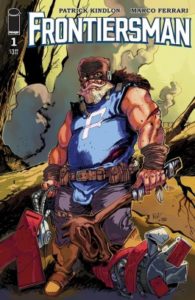
What makes a superhero? The truth is they come in a variety of shapes, sizes, motivations, and agendas. Enter Frontiersman, a retired superhero who spent his career fighting politicians and criminals who wanted to harm the environment and citizens alike. And while he was not always popular with his fellow superheroes, they knew where his motivations lay.
retired superhero who spent his career fighting politicians and criminals who wanted to harm the environment and citizens alike. And while he was not always popular with his fellow superheroes, they knew where his motivations lay.
Because of those differences, the Frontiersman has lived in relative solitude since retiring as an active superhero. His only goal in life is to enjoy his ever-growing unread pile of books. That is until a rather eager environmental activist tracks him down for help. Thus, the opportunity to save some redwood trees from greedy corporate types forces Frontiersman back into action.
From the first panel, Frontiersman #1 has a familiar feel to it. Despite this, Patrick Kindlon does an excellent job creating a story that does not feel like a retread. We are meeting Frontiersman after he is well past his glory days, which means that he has a long-unseen history behind him. Fortunately, Kindlon knew that explaining the entire backstory to the reader in Frontiersman #1 would lead to an over-bloated, exposition-heavy book that would push more readers away rather than bringing them in. Instead, Kindlon starts small and uses snippets of stories and flashback panels to show the Frontiersman’s ideologies have not changed that much over the years. Doing so presents a character whose motivations are clear. Thus, making it easier for readers to be able to connect with our protagonist.
While we do not end up with a word-vomit of exposition, it does not mean that Frontiersman #1 ignores the title character’s past. Killer robots sent from long-gone enemies and meetings with former teammates help to add depth to the Frontiersman. This character development helps to distract from the lack of a plot for the series. Frontiersman was approached to be the spokesman for an environmental group. But beyond a generic anti-environment big business, the enemy is unknown by the end of the first issue.
While the current day panels are more exposition-heavy, the flashbacks have panels filled with fast action and plenty of big explosions. Marco Ferrari does an excellent job separating the two with distinct styles. The slower-paced panels at the Frontiersman cabin and surrounding woods let the art breathe. Ferrari never overdoes it and fills the panels with unnecessary filler in the background. Instead, the openness reminds the readers just how vast and awe-inspiring nature can be. Meanwhile, the action panels are filled from the gutter to the gutter with movement that adds a certain excitement to the scenes. One moment that drives that feel home is when the Frontiersman suspects someone being in his cabin. Meanwhile, Ferrari’s choice of more muted colors within the wilderness allows the natural beauty to shine through. Alternatively, the bright colors in the action panels drive how the energy within those panels.
Frontiersman #1 makes creating a whole new superhero world look easy. By focusing on just one former hero, it avoids the pitfalls of comparisons to the big two. Instead, Kindlon lays the groundwork for a world that could hatch several new characters. Throughout the book, Kindlon is about to avoid coming off preachy without sacrificing development.



![[REVIEW] IRON MAN 2020 #1](https://geekd-out.com/wp-content/uploads/2020/01/iron-man-2020-1-featured-150x150.png)
